#Eid 2020 Date
Explore tagged Tumblr posts
Text

[ID: Seven yoghurt balls on a plate drizzled with olive oil. The one in the center is plain; the others are covered in mint, toasted sesame seeds, ground sumac, za'tar, crushed red chili pepper, and nigella seeds. End ID]
لبنة نباتية / Labna nabatia (Vegan labna)
Labna (with diacritics: "لَبْنَة"; in Levantine pronunciation sometimes "لَبَنَة" "labanay") is a Levantine cow's, sheep's, or goat's milk yoghurt that has been strained to remove the whey and leave the curd, giving it a taste and texture in between those of a thick, tart sour cream and a soft cheese. The removal of whey, in addition to increasing the yoghurt's tanginess and pungency, makes it easier to preserve: it will keep in burlap or cheesecloth for some time without refrigeration, and may be preserved for even longer by rolling it into balls and submerging the balls in olive oil. Labna stored in this way is called "لبنة كُرَات" ("labna kurāt") or "لبنة طابات" ("labna ṭābāt"), "labna balls." Labna may be spread on a plate, topped with olive oil and herbs, and eaten as a dip for breakfast or an appetizer; or spread on kmaj bread alongside herbs, olives, and dates to make sandwiches.
The word "labna" comes from the Arabic root ل ب ن (l b n), which derives from a Proto-West-Semitic term meaning "white," and produces words relating to milk, yoghurt, nursing, and chewing. The related term "لَبَن" ("laban"; also transliterated "leban") refers to milk in Standard Arabic, but in Levantine Arabic is more likely to refer to yoghurt; a speaker may specify "لَبَن رَائِب" (laban rā'ib), "curdled milk," to avoid confusion.
Labna is a much-beloved food in Palestine, with some people asserting that no Palestinian home is without a jar. Making labna tabat is, for many, a necessary preparation for the winter season. However, by the mid-2010s, the continuation of Israel's blockade of the Gaza strip, as well as Israeli military violence, had severely weakened Gaza's dairy industry to the point where almost no labna was being produced. Most of the 11 dairy processors active in Gaza in 2017 (down from 15 in 2016) only produced white cheese—though Mustafa Eid's company Khalij had recently expanded production to other forms of dairy that could be made locally with limited equipment, such as labna, yoghurt, and buttermilk.
Dairy farmers and processors pushed for this kind of innovation and self-sufficiency against deep economic disadvantage. With large swathes of Gaza's arable land rendered unusable by Israeli border policing and land mines, about 90% of farmers were forced by scarce pasture land and low fodder production to feed their herds with increasingly expensive fodder imported from Israel—dairy farmers surveyed in 2017 spent an estimated 87% of their income on fodder, which had doubled in price since 2007. Cattle were thus fed with low quantities of, or low-quality, fodder, resulting in lower milk production and lower-quality milk.
Most dairy processors were also unable to access or afford the equipment necessary to maintain, upgrade, or diversify their factories. Since 2007, Israel has tightly restricted entry into Gaza of items which they consider to have a "dual use": i.e., a potential civilian and military function. This includes medical equipment, construction materials, and agricultural equipment and machinery, and impacts everything from laboratory equipment to ensure safe food supplies to packaging and labelling equipment. Of the dairy products that Gazan farmers and processors do manage to produce, Israel's control over their export can cause huge financial losses—as when Israel prohibited the export of Palestinian dairy and meat to East Jerusalem without warning in March of 2020, costing estimated annual losses of 300 million USD.
In addition to this kind of economic manipulation, direct military violence threatens Gaza's dairy industry. Mamoun Dalloul says that his factory was accused of holding rockets and subsequently bombed in 2008, 2010, 2012, and again in 2014, resulting in repeated moves and the loss of the capability to produce yellow cheese. The Israeli military partially or totally destroyed 10 dairy processing factories, and killed almost 2,000 cows, during its 2014 invasion of Gaza, resulting in an estimated 43 million USD of damage to the dairy sector alone. Damage to cow-breeding farms in 2014 reduced the number of dairy cows to 2,600, just over half their previous number. Damage to, or destruction of, wells, water reservoirs, water tanks, and the Gaza Power Plant's fuel tank exacerbated pre-existing problems with producing cattle feed and with the transportation, processing, and refrigeration of dairy products, leading to spoiled milk that had to be disposed of. Repeated offensives made dairy processors reluctant to re-invest in equipment that could be destroyed at any time.
Israeli industry profits by making Gazan self-sufficiency untenable. Israeli goods entering Palestine are not subject to import taxes, and Israeli dairy companies are not dealing with the contaminated water, limited electricity, high costs of feed, out-of-date and expensive-to-repair equipment, and scarce land (some companies, such as Tnuva, purchase milk from farms on illegal settlements in the West Bank) with which Gazan producers must contend. The result is that the local market in Gaza is flooded with imports that are cheaper, more diverse, and of higher quality than anything that local producers can offer. Many consumers believe that Israeli products are safer to eat.
Nevertheless, Gazans continue building and rebuilding. Despite significant decreases in ice cream factories' production after the imposition of Israel's blockade in 2007, Abu Mohammad noted in 2015 that locally produced ice cream was cheaper and more varied than Israeli imports. In 2017, the amount of dairy sold in 74 shops in Gaza that was sourced locally, rather than from Israel, had increased from 10% to 60%. Ayadi Tayyiba, the region's first factory with an all-woman staff, opened in 2022; it produced cheese, yoghurt, and labna with sheep's milk from affiliated farms. However, demand for sheep's milk products has decreased in Gaza due to its higher production costs, leading the factory to supplement its supply with purchased cow's milk.
The current Israeli genocidal offensive on Gaza has caused damage of the same kind as—though to a greater extent than—previous shellings and invasions. Lack of ability to sell milk that had already been produced to factories, as well as lack of access to electricity, caused an estimated 35,000 liters of milk to spoil daily in October of 2023.
Support Palestinian resistance by calling Elbit System’s (Israel’s primary weapons manufacturer) landlord, donating to Palestine Legal's activist defense fund, and donating to Palestine Action’s bail fund.
Equipment:
A blender
A kettle or pot, to boil water
A cheesecloth or tea towel
Ingredients:
1 cup (130g) cashews (soaked, if your blender is not high-speed)
3/4 cup filtered or distilled water, boiled
1-3 vegetarian probiotic capsules (containing at least 10 billion cultures total)
A few pinches sea salt
More water, to boil
Arabic-language recipes for vegan labna use bulghur, almonds, or cashews as their base. This recipe uses cashew to achieve a smooth, creamy, non-crumbly texture, and a mild taste like that of cow's milk labna. You might try replacing half the cashews with blanched almonds for a flavor more similar to that of sheep's or goat's cheese.
Make sure your probiotic capsules contain no prebiotics, as they can interfere with the culture. The probiotic may be multi-strain, but should contain some of: Lactobacillus casei, Lactobacillus rhamnosus, Bifidobacterium bifidus, Lactobacillus acidophilus. The number of capsules you need will depend on how many cultures each capsule is guaranteed to contain.
Instead of probiotic capsules, you can use a speciality starter culture pack intended for use in culturing vegan dairy, many of which are available online. Note that starter cultures may be packaged with small amounts of powdered milk for the bacteria to feed on, and may not be truly vegan.
If you want a mustier, goat-ier taste to your labna, try replacing the water with rejuvelac made with wheat berries.
You can also start a culture by using any other product with active cultures, such as a spoonful of vegan cultured yoghurt. If you have a lot of cultured yoghurt, you can just skip to straining that directly (step 5) to make your labna—though you won't be able to control how tangy the labna is that way.
Instructions:
This recipe works by blending together cashews and water into a smooth, creamy spread, then culturing it into yoghurt, and then straining it (the way yoghurt is strained to make labna). It's possible that you could skip the straining step by adding more cashews, or less water, to the yoghurt to obtain a thicker texture, but I have not tested the recipe this way.
1. If your blender is not high-speed, you will need to soak your cashews to soften them. Soak in filtered or distilled water for 2-4 hours at room temperature, or overnight in the fridge. Rinse them off with just-boiled water.
2. Boil several cups of water and use the just-boiled water to rinse your blender, tamper, measuring cups, the bowl you will ferment your yoghurt in, and a wooden spoon or rubber spatula to stir. Your bowl and stirring implement should be in a non-reactive material such as wood, clay, glass, or silicone.
3. Make the yoghurt. Blend cashews with 3/4 cup just-boiled water for a couple of minutes until very smooth. Transfer to your bowl and allow to cool to about skin temperature (it should feel slightly warm if dabbed on the inside of your wrist). If the mixture is too hot, it may kill the bacteria.
4. Culture the yoghurt. Open the probiotic capsules and stir the powder into the cashew paste. Cover the bowl with a cheesecloth or tea towel. Ferment for 24 hours: on the countertop in summer, or in an oven with the light on in winter.
Taste the yoghurt with a clean implement (avoid double-dipping!). Continue fermenting for another 12-24 hours, depending on how tangy you want your labna to be. A skin forming on top of the yoghurt is no problem and can be mixed back in. Discard any yoghurt that grows mold of any kind.
5. Strain the yoghurt to make labna. Place a mesh strainer in a bowl, making sure there's enough room beneath the strainer for liquid to collect at the bottom of the bowl; line the strainer with cheesecloth or a tea towel, and scoop the cultured yoghurt in. Sprinkle salt over top of the yoghurt. Fold the towel or cheesecloth back over the yoghurt, and add a small weight, such as a ceramic plate or a can of beans, on top.
You can also tie the cheesecloth into a bag around a wooden spoon and place the wooden spoon across the rim of a pitcher or other tall container to collect the whey. The draining may occur less quickly without the weight, though.
Strain in the refrigerator for 24-48 hours, depending on the desired texture. I ended up draining about 2 Tbsp of whey.
6. If not making labna balls: Put in an airtight jar, and add just enough olive oil to cover the surface of the labna. Store in the fridge for up to two months.
7. To form balls (optional): Oil your hands to form the labna into small balls and place them on a baking sheet lined with parchment paper. They may still be quite soft.
Optionally sprinkle with, or roll in, dried mint, za'tar, sesame seeds, nigella seeds (القزحة), ground sumac, or crushed red chili pepper, as desired.
Optionally, for firmer balls, lightly cover with another layer of parchment paper and then a kitchen towel, and leave in the refrigerator to dry for about a day.
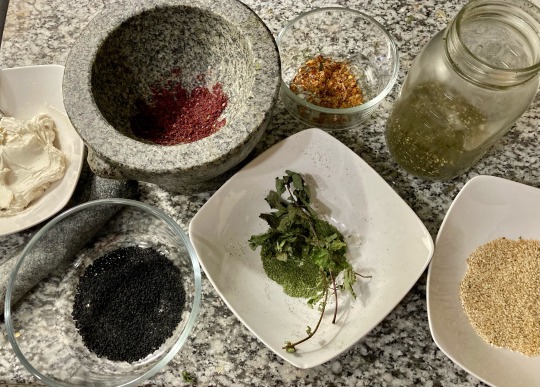
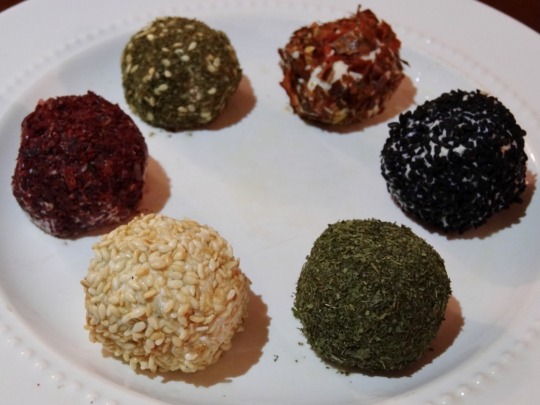
Place labna balls in a clean glass jar and add olive oil to cover. Retrieve labna from the jar with a clean implement. They will last in the fridge for about a year.
551 notes
·
View notes
Text


Late, I know, but…! Only by two days, so I’ll still label/tag it:
Ichihime Week, Day 7: Mythical Lovers / Rainbow
I was planning on adding in magpies in the background this time, but I was getting lazy, and it’s already late, so maybe next time ^^;
(Also I was thinking of making a rainbow version, but it didn't come out as I would have liked? Idk. I still think it’s cute, though, so I put it under the cut)

Alrighty, listen: I really didn’t mean to wait this long to post. But, like, very shortly after Eid, my iPad’s storage filled up, like, to the point I couldn’t even access my mail (that’s how I found out, pfft). I was wondering why I’d ever need 256 GB 4 years ago… but still, it was $100 extra bucks. Sure, it was a grad gift, but 128 GB was expensive enough—still a lot of storage, too… Not enough, clearly!
Hoarding layers (and recoloring my own art, pfft) has really caught up to me… but also, it wouldn’t help too much if I didn’t either. After deleting what I could bear to part with, that took away around 5 GB, but merging layers in other works barely made a dent.
So I’ve spent these past few weeks wondering what to do, thinking about emailing my 2019 (imported from my 5s) and 2020 works to an email I also created 4 years ago for some reason I totally forgot about and never used so that I don’t end up taking any space in my actual one and then uploading them onto two (since I really don’t want my files corrupting) USBs via my laptop, trying to get those USBs from Target (but since I was adamant this time in getting 256 GB USBs—I don’t want to have to worry about storage for a longgggg time—there were none in stock), ordering them off of eBay instead since my dad insisted on their cheapness, waiting a week for them, then transferring them to that email and uploading them onto its Google drive if the files was too big…
But that was taking much too long and still left space on my iPad while I was doing it. I managed to complete the 2019 and 2020 pieces from my iPad, but it also only ended up being around 1 GB… So, like, I need to clear more years (breaks my heart, it does ;~; Sure, I still have access to them via that email and those USBs, but it’s not convenient anymore, and there are still pieces I plan on getting back to… ackkkkk).
Contemplating it some more and discussing it with a friend, much as I abhor subscription services, I finally decided to purchase a premium membership on Ibis for that 20 GB of cloud storage. I can afford the 30 bucks a year, and I like the app anyway—serves me good—and not having to watch an ad every 18 hours to access my go-to brushes would be nice, plus having access to the other stuff, but yeah: ✋🌈✨cloud storage✨🌈 🤚
Anyway, I’m pretty sure a good chunk of what’s taking up my space is actually the cache, as I’m already more than halfway through my drawings, and I’m not sure if I’ll reach that 75 GB of storage Ibis was apparently taking up with just my drawings. So I’ll probably need to download everything, then delete the app and redownload it ‘cause stupid IOS doesn’t let you easily clear it 🫠
Anyway, I really thought I’d be done by now, but am not—that said, I managed to clear out around 10 GB off of Ibis (not my iPad; I somehow managed to gain back 5?? Somewhere?? I’ve no clue; I don’t see it), which is wayyy more than enough to get one drawing done for IH week, so I paused the whole storage thing for now. I actually tried to get day one’s drawing done on the 6th, but I’m dealing with perspective that’s hurting my brain, so I decided to get day seven’s done instead, ‘cause I thought I’d be on time…
Me? On time? Man, who knew I was so funny… 😒
But yeah, day seven is done! I’ll definitely revisit that day one drawing in the future, but not anytime soon. As if I wasn’t backed up already, this whole storage mess has backlogged even further, and there are other dates coming up 😮💨 And, y’know, gotta finish the storage transfer, too… Ahhhhhhhhhh!
Anyway, on a more positive note, gradient maps are actually very neat to use—had a little too much fun, eheh. I won’t confess how much time I spent testing it out on this piece, but here be my favorite:

They’re so golden <3 ☺️
#bleach#inoue orihime#kurosaki ichigo#ichihime#ihweek2024#ichihime week#fanart#digital art#the cons of digital art man…#and well me being a hoarder too but shhhh 🤫
94 notes
·
View notes
Photo
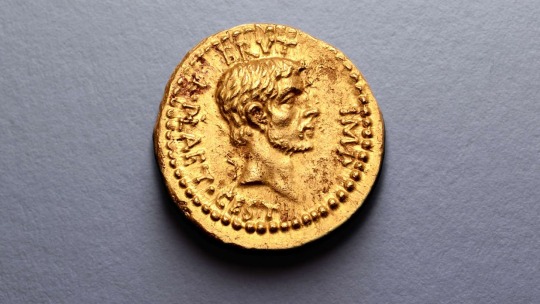
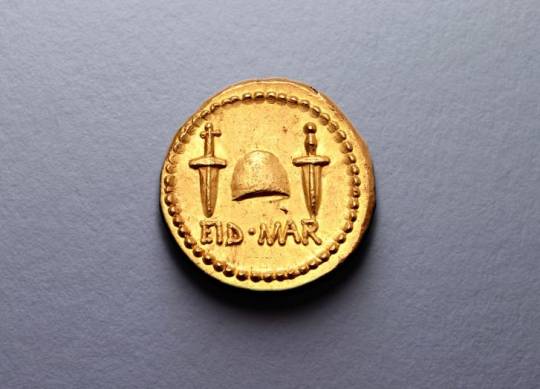
Very Rare Roman Gold Coin is Returned to Greece
A Very Rare Gold Coin, Minted by Brutus to Mark Caesar’s Death, Is Returned to Greece
The gold coin, which dates from 42 B.C. and is valued at $4.2 million, is thought to have been looted from a field near where an army loyal to Brutus camped during the struggle for control of Rome.
A rare and ancient gold coin that morbidly celebrates the stabbing death of Julius Caesar was returned this week to Greek officials by investigators in New York who had determined it was looted and fraudulently put up for sale at auction in 2020.
The coin, known as the “Eid Mar” and valued at $4.2 million, features the face of Marcus Junius Brutus, the onetime friend and ally of Caesar who, along with other Roman senators, murdered him on the Ides of March in 44 B.C. According to historians and experts, Brutus had the coins minted in gold and silver to applaud Caesar’s downfall and to pay his soldiers during the civil war that followed the killing.
The return Tuesday came at a ceremony attended by officials of the Manhattan district attorney’s Antiquities Trafficking Unit and U.S. Homeland Security Investigations, who cooperated on the case.
The coin, one of 29 artifacts returned to Greek officials, was given up earlier this year by an unidentified American billionaire who, investigators said, had bought it in good faith in 2020. The British dealer who helped to arrange the sale was arrested in January, and the coin itself was recovered in February, officials said.
Experts said the coin, minted two years after Caesar’s death, is about the size of a nickel and weighs about 8 grams, and is one of only three known to be in circulation. A silver version of the coin was also minted and about 100 are known to exist. Those can sell for $200,000 to $400,000.
“The Eid Mar is an undisputed masterpiece of ancient coinage,” Mark Salzberg, the chairman of Numismatic Guaranty Corp., which verified the coin but does not research provenances, said in a statement in 2020.
Experts said they believe the coin was likely discovered more than a decade ago in an area of current-day Greece where Brutus and his civil war ally, Gaius Cassius Longinus, were encamped with their army.
The front, or obverse, of the coin features an engraved side view of Brutus and the Latin letters “BRVT IMP” and “L PLAET CEST.” Experts say the former stands for “Brutus, Imperator,” with imperator referring not to emperor but to commander. The latter stands for Lucius Plaetorius Cestianus, who was a treasurer of sorts for Brutus and oversaw the minting and assaying of his coins.
The reverse features two daggers on either side of a cap known as a pileus. The daggers stand for Brutus and Cassius and reflect the manner of Caesar’s death, experts say, while the cap is a symbol of liberty that was worn by freed slaves. Overall, the image is meant to celebrate the murder as an act by which Rome was liberated from Caesar’s tyranny. Beneath the symbols is the Latin inscription “EID MAR,” designating the Ides of March — March 15, 44 B.C. — the fateful day on which the conspirators left Caesar dead on the floor of the Roman Senate.
Historians see irony in the fact that Brutus, who had admonished Caesar before the murder for the self-aggrandizing act of putting his face on Roman coinage, wound up doing the same with his own coins.
Ultimately, the forces who favored the dead Caesar, led by Mark Antony and others, defeated Brutus and his men in October of 42 B.C. at the Second Battle of Philippi, and Brutus and Cassius committed suicide.
According to investigators, the coin is first thought to have come to market between 2013 and 2014. Richard Beale, 38, director of the London-based auction house Roma Numismatics, put it up for sale on his company’s website and over several years shopped it at coin shows in the United States and Europe before it was sold in October 2020. The $4.2 million was the most ever paid for an ancient coin, according to the Numismatic Guaranty Corp.
Mr. Beale is charged with grand larceny in the first degree and several other felonies and was released on his own recognizance. His lawyer, Henry E. Mazurek, declined to comment on the case.
Among the other Greek antiquities repatriated on Tuesday were figurines of people and animals; marble, silver, bronze and clay vessels; and gold and bronze jewelry. Their total value was put at $20 million.
In remarks at the ceremony, Konstantinos Konstantinou, Greece’s consul general in New York, said his country has been hit hard by the illicit trading of antiquities and is seeking their return “in every possible way.”
He praised investigators for “striking down the illegal international criminal networks whose activity distorts the identity of peoples, as it cuts off archaeological finds from their context and transforms them from evidence of people’s history into mere works of art.”
By Tom Mashberg.
#Very Rare Roman Gold Coin is Returned to Greece#Julius Caesar#Marcus Junius Brutus#Eid Mar#gold#gold coin#collectable coin#ancient artifacts#history#history news#ancient history#ancient culture#ancient civilizations#roman history#roman empire#Mark Antony#Second Battle of Philippi#long reads
214 notes
·
View notes
Photo

Eid Shayari: ‘ईद का दिन है गले मिल लीजे…’ बकरीद के मौके पर शायरी भेजकर दें खास अंदाज में बधाइयां Happy Eid-Al-Adha 2020: बकरीद के खास मौके पर शायरी भेजकर दें बधाइयां खास बातें ईद के मौके पर दोस्तों को शायरी भेजकर दें बधाई
#bakra eid#Bakrid#Bakrid 2020#bakrid in india 2020#bakrid kab hai 2020#bakrid shayari#bakrid wishes#eid 2020#eid 2020 date#eid al adha mubarak#Eid al-Adha#eid mubarak#eid mubarak images#Eid Shayari#Eid Shayari in Hindi#eid ul adha#eid ul adha mubarak#Eid Ul Adha Shayari#ईद उल अदहा#बकरीद#बकरीद 2020#बकरीद मैसेज#बकरीद शायरी#बकरीद शायरी हिंदी
0 notes
Photo

Eid al-Adha 2020: tell your close friends on Bakrid in a different way Bakrid festival will be celebrated across the country on 1 August. It is also called Eid-ul-Azha or Eid-ul Juha.
#bakra eid#bakra eid 2020#bakra eid date#bakra eid date 2020#bakri id#bakrid#bakrid 2020 date#bakrid in india 2020#bakrid kab hai 2020#bakrid wishes#Eid#eid 2020#eid 2020 date#eid al adha#eid al adha mubarak#eid mubarak#eid mubarak 2020#eid mubarak images#eid mubarak pics#eid ul adha#eid ul adha 2020#eid ul adha mubarak#eid ul-adha 2020 in india#when is bakrid#when is eid
0 notes
Text
Bakrid 2020 WhatsApp Messages, Wishes and Quotes to Share with Your Loved Ones
Bakrid 2020 WhatsApp Messages, Wishes and Quotes to Share with Your Loved Ones
[ad_1]
Eid al-Adha or more commonly known as Bakrid will be celebrated on July 31 this year across the globe. This date has been announced by Saudi Arabia. However, it must be noted that the Shahi Imam of Jama Masjid in Delhi has said that Bakrid will be celebrated on August 1 as per the sighting of the moon.
The festival is celebrated during ‘Dhu al-Hijjah’ – the twelfth and the last month in…
View On WordPress
#bakra eid#bakra eid 2020#Bakrid#Bakrid 2020#Bakrid greetings#Bakrid WhatsApp messages#Bakrid wishes#Eid 2020#eid 2020 date#eid 2020 july#Eid al-Adha#Eid Mubarak#eid ul-adha 2020 in india#Eid-ul-Adha
0 notes
Text
Bakrid 2020: भारत में कब है बकरीद, जानें ईद-उल-अजहा पर कुर्बानी का महत्व
Bakrid 2020: भारत में कब है बकरीद, जानें ईद-उल-अजहा पर कुर्बानी का महत्व
[ad_1]

भारत में कब है बकरीद, जानें ईद अल-अधा 2020 की तारीख (Eid al-Adha 2020 Date) : इस्लाम धर्म में बकरीद 2020 का त्योहार इब्राहिम के प्रति सम्मान प्रकट करने के लिए मनाया जाता है. अल्लाह के आदेश को मानते हुए इब्राहीम (Ibrahim) अपने बेटे इस्माइल की…
View On WordPress
#bakra eid#bakra eid 2020#bakri id#bakrid#bakrid 2020#bakrid kab hai 2020#eid 2020#eid 2020 date#eid 2020 july#eid al adha#eid mubarak#eid ul adha#eid ul-adha 2020 in india#बकरा ईद कब है#बकरीद कब है
0 notes
Text
eid mubarak to all my muslim followers 🥰
50 notes
·
View notes
Text

Eid Mubarak to All.
May Allah's peace always fill your hearts and home. Ameen.
- @holyquraansays
33 notes
·
View notes
Text
Eid-ul-Azha Mubarik to everyone. ✨
عید مبارک ☺️
May Allah Pak accept our sacrifices and prayers.
Stay Blessed 🦋
Regards,
meryalfaz 🌿
30 notes
·
View notes
Text
Eid Mubarak to you and your family!
Taqabbalallahu minna wa minkum ✨
40 notes
·
View notes
Text

Eid Mubarak to my fellow moeslim fam. Since there is no family visit this year we don't have any Eid pic so please enjoy my Shoto's drawing in Turban and Abaya instead. Don't forget to practice healthy life style and don't go outside unless necessary.
#bnha shoto todoroki#shoto x reader#shoto torodoki#bnha shoto#todoroki x reader#todoroki shouto x reader#mha todoroki#bnha#mha fanart#mha#eid date 2020#happy eid#eidfashion#anime fanart
22 notes
·
View notes
Text
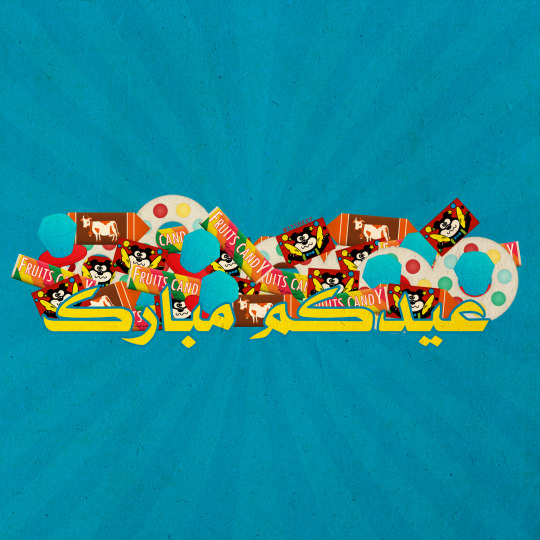
عيدكم مبارك
#عيد الفطر 2020#عيد مبارك#عيد الفطر المبارك#عيدكم مبارك#عيدكم سعيد#عيدكم مبارك وكل عام وانتم بخير#عيدك في بيتك#كل عام وانتم بخير#happy eid ul fitr 2020 greetings#happy eid ul fitr 2020 images#happy eid mubarak#happy eid ul fitr 2020 wishes#happy eid wishes#eid date 2020#eidfashion#eid anarkali#eid#عساكم من عواده#من العايدين#illustrator#illustration#retro art#vintage art#photoshop#عرب تمبلر#تمبلر بالعربي#تمبلر#آل تمبلر#اهل تمبلر#pop art
21 notes
·
View notes
Text
Eid Mubarak to all those celebrating! Also a special shoutout to those of us who aren’t able to go home and celebrate with family because of the pandemic! ❤️
عيد مبارك سعيد، وتقبل الله صيامكم!
#studyblr#study motivation#kpop#kpopstudynet#motivation#study advice#kdrama#bts#math#studyspo#muslim#eid#eid date 2020#happy eid ul fitr 2020 greetings
22 notes
·
View notes

